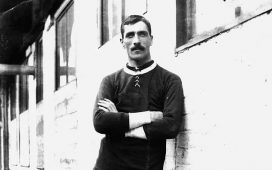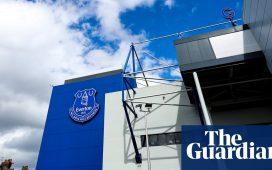Everton gave fans a look into the future as the club revealed plans for their £500million waterfront stadium.
The Toffees want to take advantage of the unused Bramley-Moore Dock site – which is part of the wider Liverpool Waters development – and are hopeful they can move into their striking new ground in time for the 2023-24 campaign.
One of the most eye-catching features of the proposed new ground is the 13,000-seat South Stand which resembles the designs used by Borussia Dortmund, and more recently Tottenham at their new stadium.

Everton have revealed striking new images to their supporters of their new proposed £500million waterfront stadium

The Toffees want to take advantage of the unused Bramley-Moore Dock site and are plotting a modern 52,000-seater arena

It would feature a 13,000 South Stand which the club hope will replicate the famous ‘Yellow Wall’ at Borussia Dortmund
Architects behind the designs feel the brick and steel construction will make it look ‘as though it has risen from the dock’ in tribute to Liverpool’s maritime past.
Rail-seating is set to play a role in the new design in case regulation is altered in the future with regards to safe standing.
The club are suspected to submit a detailed planning application by the end of 2019 and then a three-year building project would commence from 2020.
Close to 800 Everton supporters were shown the latest designs at a fans event on Thursday night.

A video capturing the proposals was posted to the club’s official social media channels as the architects showed their work

If given the go ahead following a planning application, it would go on to spark major regeneration across the city’s dockland

As part of ‘The Peeople’s Project’, a graphic was revealed which highlighted the various intricacies of the new stadium design
While the initial capacity is set to be 52,000, it is believed the club could add a further 10,000 on top if attendances regularly reached a sell-out.
Should planning permission be given and the club press on with the project, Everton’s current home at Goodison Park would not find itself picking up dust for too long.
The club plan to redevelop the site of Goodison Park to create ‘a range of assets such as homes, health, education and enterprise amenities’ as they look to ensure the site remains a key part of the community.
Goodison Park has been the home of the club for 127 years and a move away to a new stadium would bring to an end more than a century of history.
The club’s plans have been referred to as ‘The People’s Project’ as consultation over designs and plans remain ongoing with supporters.
Leighton Baines has been a long servant for the club, pulling on an Everton shirt since joining in 2007. But he accepts it is unlikely he will get to lead out the Toffees at the new stadium.
‘It’s definitely a stretch to imagine me running out there as a player but one thing’s for sure I’ll at least be there as an Evertonian,’ said the 34-year-old Baines, who signed a new one-year contract last month.
‘The designs and the planning have been done with Goodison in mind and trying to recreate as much of that atmosphere and feeling of intimacy as we can and that’s great to hear.
‘The times are that you always have to keep moving and growing, whether that be as a person, a business, a football club so we’ll try to continue that and bring our own history and develop our soul at the new stadium.’
It remains unclear whether the stadium name will link back to Goodison Park or whether it will be sold to a company to help fund the project.
But Everton are confident funding for the project will be in place in time for when pre-construction works begin early next year.
‘It is exceptionally important for us commercially in terms of naming rights, extension to our hospitality and getting fans in through the turnstiles to increase our numbers,’ said chief executive Denise Barrett-Baxendale.
‘We are looking at it (stadium naming rights) now and are working on different commercial opportunities and offers and I am sure when people see the visuals and the opportunities it presents for a brand it takes the conversations even further.’
If plans are accepted by the council it would represent a major boost for the city’s economy. Construction of the stadium would kick-start major regeneration in the north of the city, which is one of the most deprived areas in the UK.

The ground has been proposed to be situated at the currently unused Bramley-Moore dockland area in the north of the city

Leighton Baines hailed the proposals but accepted it remains highly unlikely that he will ever lead Everton out at the ground
Research has suggested that the plans would deliver a £1bn boost to the city’s economy with the potential for up to 15,000 new jobs generating £34m to local businesses.
Professor Denise Barrett-Baxendale, Everton’s Chief Executive Officer, said: ‘Today marks an incredibly important milestone for us as we seek to build a new stadium which will act as a ‘game changer’ for the Club and our city region.
‘Our proposed stadium design takes its inspiration from both our city’s maritime history and from our Club’s rich heritage and traditions.
‘It is, first and foremost, a stadium for football, for our passionate fans and for our players. A stadium that gives Everton Football Club a platform for growth both commercially and socially. But it is also a stadium for the entire city and a development which will deliver transformative benefits in terms of regeneration and inclusive growth for the whole Liverpool City Region and for North Liverpool in particular.








